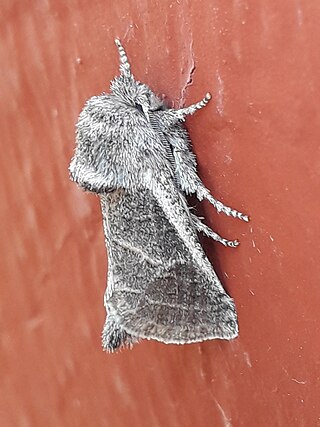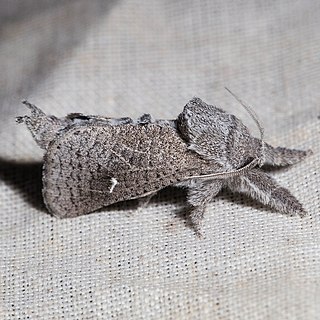Chrismania is a monotypic moth genus of the family Crambidae. Its only species, Chrismania pictipennalis, is found in North America, where it has been recorded from southern California and Arizona. Both the genus and species were first described by William Barnes and James Halliday McDunnough in 1914.
Dichozoma is a monotypic moth genus of the family Crambidae erected by Eugene G. Munroe in 1961. Its only species, Dichozoma parvipicta, was first described by William Barnes and James Halliday McDunnough in 1918. It is found in North America, where it has been recorded from Arizona, California, Utah and Texas.
Fania connectus is a species of moth of the family Cossidae first described by William Barnes and James Halliday McDunnough in 1916. It is found in Texas in the United States.
Comadia is a genus of moths in the family Cossidae first described by William Barnes and James Halliday McDunnough in 1911.
Comadia bertholdi, the lupine borer moth, is a moth in the family Cossidae. It is found in the United States, where it has been recorded from Washington, Colorado, Wyoming, Arizona, California, Nevada and New Mexico.
Comadia intrusa is a moth in the family Cossidae first described by William Barnes and Foster Hendrickson Benjamin in 1923. It is found in North America, where it has been recorded from New Mexico, Arizona and California.

Comadia redtenbacheri is a moth in the family Cossidae. It is found in North America, where it has been recorded from Mexico and southern Texas.
Comadia suaedivora is a moth in the family Cossidae. It is found in North America, where it has been recorded from California.
Comadia subterminata is a moth in the family Cossidae first described by William Barnes and Foster Hendrickson Benjamin in 1923. It is found in North America, where it has been recorded from Arizona, Utah, Colorado and New Mexico.
Comadia alleni is a moth in the family Cossidae. It is found in North America, where it has been recorded from California.
Comadia arenae is a moth in the family Cossidae. It is found in North America, where it has been recorded from California.
Comadia speratus is a moth in the family Cossidae. It is found in North America, where it has been recorded from California.

Hypopta palmata is a moth in the family Cossidae first described by William Barnes and James Halliday McDunnough in 1910. It is found in North America, where it has been recorded from western Texas, Arizona, Nevada, California and Baja California Norte. The habitat consists of deserts and desert mountains.

Givira lotta, the pine carpenterworm moth, is a moth in the family Cossidae. The species was first described by William Barnes and James Halliday McDunnough in 1910. It is found in the United States, where it has been recorded from California, Arizona, New Mexico and Colorado. The habitat consists of pine forests.

Givira marga is a moth in the family Cossidae first described by William Barnes and James Halliday McDunnough in 1910. It is found in North America, where it has been recorded from California and Arizona.

Givira minuta is a moth in the family Cossidae first described by William Barnes and James Halliday McDunnough in 1910. It is found in North America, where it has been recorded from southern Arizona.

Givira lucretia is a moth in the family Cossidae first described by William Barnes and James Halliday McDunnough in 1913. It is found in North America, where it has been recorded from Arizona, Texas and Wyoming.
Cornifrons actualis is a moth in the family Crambidae. It was described by William Barnes and James Halliday McDunnough in 1918. It is found in North America, where it has been recorded from Arizona, California, Montana, Nevada, Texas and Utah. The habitat consists of deserts.
Pyrausta zonalis is a moth in the family Crambidae. It was described by William Barnes and James Halliday McDunnough in 1918. It is found in North America, where it has been recorded from Texas, Arizona and California.
Noctueliopsis virula is a moth in the family Crambidae. It was described by William Barnes and James Halliday McDunnough in 1918. It is found in North America, where it has been recorded from Arizona, California and Nevada.





